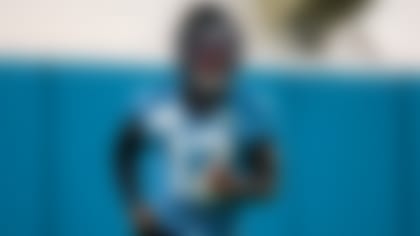On Thursday, as if to remind their fans of what might still be, the Houston Texans noted on their website that exactly a year ago they were covering Jadeveon Clowney's pro day at South Carolina. The videos document what everybody saw that day -- the eye-popping athleticism, the burst and movement that drew comparisons to Lawrence Taylor and convinced the Texans to make Clowney the first overall draft pick a month later. Clowney wept backstage when his name was announced at Radio City Music Hall and Johnny Manziel jumped up to embrace him.
It was hard not to wonder, watching those highlights this week and remembering that night, if Clowney will ever have those kinds of days again, where he wows with his explosiveness and disruptiveness, where he is a very tall and very fast vessel for the Texans' hope and optimism. As another draft approaches, Clowney seems like a shadow first-rounder, not so much a bust but an unknown. He played in just four games last year. He has nearly disappeared from public view, receding into an arduous and sometimes mind-numbingly monotonous rehab schedule that might return him to what he was or merely could represent another few months toward a premature decline.
There is no way for Clowney, his doctors or coaches to know right now exactly which way his recovery from microfracture surgery on his right knee will go. Texans coach Bill O'Brien said last week at the NFL Annual Meeting that Clowney had just experienced his best week of work in rehab. In a brief interview with the Houston Chronicle during an appearance at a local store last weekend, Clowney, in his first remarks since his December surgery, said he was very encouraged.
But that's as far as anyone can go this early in the process. Recovery from microfracture surgery is a long ordeal -- nine or 10 months is the usual prediction -- although Clowney might have already gone through the worst part of it: the six to eight weeks of forced immobility immediately after the surgery, when patients are not allowed to put any weight on the repaired leg.
Microfracture is a common and relatively uncomplicated procedure. Doctors drill tiny holes into the bone plate, which allows blood and bone marrow to leak out. That forms a blood clot full of cartilage-building stem cells. The intent is for that to form a cushion between the bones. One man with a lot of experience in performing microfracture procedures is Nicholas DiNubile, the Philadelphia 76ers former team doctor and a spokesman for the American Academy of Orthopaedic Surgeons. He equates the procedure to trying to fill a pothole. The question is how big was the "pothole" in Clowney's knee -- a bigger pothole makes recovery more difficult.
That first period after surgery is when cells are forming, DiNubile said, and a patient's leg is often attached to a machine that slowly rocks the knee back and forth. At about eight weeks, there is enough of a gel between the bones to gently put weight on it, but a patient cannot run on it. Slowly the gel gets firmer. But the process can take up to two years to complete.
"The real issue is how much regeneration happens," said DiNubile, who has read up on Clowney's case but has not examined him. "To even require microfracture is a bad thing at a young age. It means you've damaged the joint cushion down to the bone. Even with the best results, it does not fill in with a normal cushion. It fills in with hybrid material -- cartilage cells and scar tissue."
The good news is that if Clowney recovers well, there is no reason why he can't return to the player the Texans hoped he would be when they drafted him.
"If all goes perfectly and he gets a nice fill in there -- it's almost like people who are bald and are using something ... some get nothing, some get peach fuzz and some get everything -- if he gets a nice fill and he rehabs well, he should be able to do what he's done before," DiNubile said. "If he gets a partial fill, then the knee is going to be cranky and it's going to act like a knee that has a problem. As far as speed and burst, he should be able to get that. The real question is, how long does it hold up?"
The risk is that if Clowney were to return too soon, the gel would not have a chance to firm up enough into cartilage and he might require a second microfracture surgery.
That said, professional athletes have returned well from the surgery. Amar'e Stoudemire had it when he was 22 and returned to make an All-NBA First Team and five All-Star games. Stoudemire's lesion was reported to be about one centimeter. A lesion greater than two centimeters are more problematic. Clowney and the Texans have not indicated how big his lesion is.
"His career could be shortened by something like this if it's a large enough lesion," DiNubile said. "But they make up for a lot of it. They are so fit and so strong. They can do more than the average patient. A lot of them have a really good pain threshold."
Clowney, in his comments to the Houston Chronicle, said he was making progress, "but we're not going to rush it."
The hope is that Clowney can get back on the field toward the end of training camp, in August. That would be about eight months after his surgery, a reasonable projection for him to start running and cutting, DiNubile said. The next key indicator will be if his knee can tolerate the increasing activity -- if Clowney needs days off for soreness or swelling, that is a bad sign.
Before he was drafted, there were concerns about Clowney's desire, about the nagging injuries that bedeviled him at South Carolina, about Steve Spurrier's public questioning of his work ethic. His very limited debut last season did nothing to answer the fundamental question about Clowney: Does he have the will to match his skill? In the long hours he will spend rehabbing his repaired knee, many of them while his teammates are practicing without him, Clowney might finally be able to provide an answer.
"Like I tell him, it'll all come down to what he does when he puts the pads on," O'Brien said last week in Arizona. "Can he stay? Can he take care of his body? There's no question about his ability to affect the game. He's a hell of a player, but he's got to be out there."
Follow Judy Battista on Twitter @judybattista.












